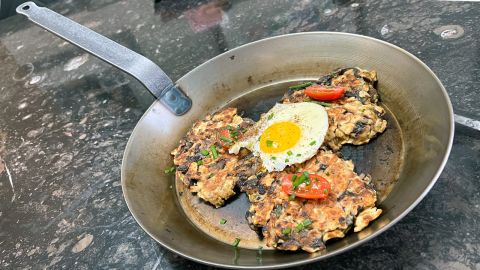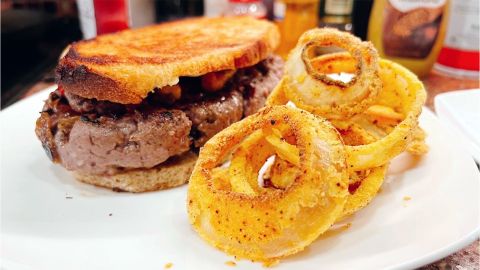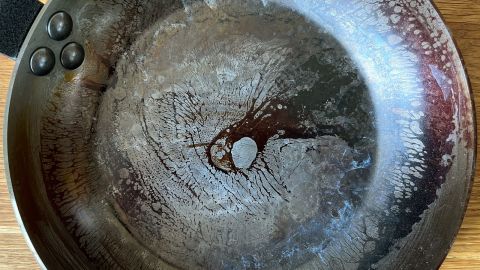Carbon steel pans — versatile, durable workhorses that can go from the stovetop to the oven and are easy to care for — are a staple in restaurant kitchens, and they’re more popular than ever for home use. For ambitious home cooks who aspire to achieve results like professional chefs, professional cookware can help (though of course knowledge, technical skills, and experience are vital to cooking restaurant-quality meals).
Over eight weeks, we looked at eight top carbon steel pans for restaurant and home use and sautéed, baked, deep fried, seared and simmered a wide range of dishes to find the best ones for your kitchen.
$99.95 at Amazon

Made in France, the de Buyer Mineral B was one of the deepest (2.06”), the second widest (12.50”), and also the heaviest (96oz) pan we tested. If you’re looking to cook large proteins, and want thick, heavy metal construction, with a lot of depth (for stir-fries, fried chicken, and other single-pan dishes), the de Buyer is absolutely the pan you want to get. This is a multitasker that can be used to cook just about any meal on your stove or in your oven you can think of, and it is worth every penny — it will become your main kitchen workhorse.
We love that this pan has two handles – one main, smooth long handle (which is attached with three short rivets) and a loop-shaped grabbing handle so that you can carry it – with potholders – in and out of a hot oven. It can easily double as a casserole dish because of the second handle, making Mac and cheese, roast chicken, or cornbread a little easier to deal with. Note that there are many versions of this pan, including a single-handle model that performs the same and is also a good choice if you don’t feel you need the handling assist.
Like many high-quality carbon steel cookware pieces, the de Buyer ships from the factory coated in beeswax, so you will want to melt that off in the oven before seasoning.
$66 $53.99 at Amazon

The Matfer Bourgeat isn’t quite as deep as the de Buyer (1.75”) or as wide (11 7/8”), but it’s thick, heavy (78.50 oz) and designed to take some serious abuse in a French restaurant kitchen. And, of course, it is significantly less expensive than our top pick without giving up much in performance. It’s deep enough to handle frying ( some of the other budget pans were too shallow to cover all the bases) and performed well in all of our testing.
The textured handle is about the same quality as the de Buyer or the Mauviel, though it is arc welded to the pan instead of being attached with rivets, so it doesn’t have the finished, crafted look of the de Buyer. The Matfer Bourgeat pan we tested doesn’t have a second handle, so you’ll want to take a little more care moving it in or out of the oven. However, it gave us equivalent results and was still easy to handle, and you can’t complain about it at this price point given its overall quality.
What you need to know about carbon steel pans

Carbon steel pans are the go-to cookware in restaurant kitchens because they’re versatile enough to handle low heat cooking of delicate foods such as eggs and crepes and high heat sears of proteins such as fish filets and steaks with equal aplomb.
They aren’t typically as pretty as cast iron or stainless steel cookware, largely because carbon steel pans haven’t historically been designed with aesthetic considerations in mind. These are working pans, meant exclusively for use in restaurant kitchens.
Carbon steel pans are becoming more common in the home kitchen as home chefs recognize their advantages. Carbon steel cookware is considerably lighter and easier to manage than cast iron, responds quickly to heat changes since it’s so thin, and is much tougher than aluminum or stainless cookware — carbon steel can go from a high-power gas burner right into a blazing hot pizza oven, conditions that an aluminum or stainless pan might not survive. And since they’re ferrous, carbon steel pans work fine with induction cooktops, which are also making headway in home kitchens.
Carbon steel (in French restaurants the material is referred to as acier bleu, “blue steel”) is a type of steel alloy that contains up to 2.1 percent carbon by weight which is a higher carbon content than other steels – that typically have a carbon content of up to .3 percent or as low as 0.05 percent. The addition of that extra carbon to the alloy increases tensile strength.
Carbon steel pans are available in a wide range of sizes and depths, from petite blini pans to specialized crepe pans to the common 8”, 10” and 12” restaurant workhorses. For this piece we focused on 12” all-purpose pans from each manufacturer for an apples-to-apples comparison.
Seasoning and caring for a carbon steel pan

With use, a carbon steel pan builds up a layer of polymerized oils known as “seasoning,” giving the pan an easy-release, near nonstick finish. A little care and maintenance can help you build up and preserve this finish so your carbon steel pans give you a lifetime of service. — Michael Berk/CNN Underscored
Many carbon steel pans ship from the factory coated in wax, which needs to be melted off in an oven at high heat before the pan can be used. Over time, after dozens of uses, the surface of a carbon steel pan will discolor and darken due to the oxidation of polymerized oils, which creates a naturally non-stick surface in a process known as “seasoning”.
Initial seasoning involves coating a pan with vegetable oil and heating the pan to high heat. You’ll likely want to turn off your smoke detector if you’re doing this indoors, and make sure to open windows for plenty of ventilation during the initial seasoning process (and when melting off the shipping wax). Things can get smoky! A pan may need to be seasoned as many as ten or more times before it becomes sufficiently nonstick — though the best way to season it is simply to cook with it.
Some carbon steel pans, such as the Lodge, can be purchased pre-seasoned, but the factory coating on these is typically rough and not as built up as it would be over long use — preseasoning doesn’t get you to the finish line but does give you a head start on, so it doesn’t take quite as long to get that slippery non-stick quick release effect.
While carbon steel is strong and durable, it isn’t meant to remain pristine — with use, carbon steel pans will look visibly discolored, and the thin material picks up dents and dings in a busy kitchen. With only one exception all the pans we tested experienced some natural warping when heated, after which they didn’t sit perfectly flat on top of induction, glass, or ceramic topped electric ranges.
To clean a carbon steel pan, use a paper towel or a kitchen towel to wipe out any excess oil and moisture from your pan. If any food particles get stuck, you can add two tablespoons of coarse salt and two tablespoons of canola oil, vegetable, or grapeseed oil, to your pan. Using a paper or kitchen towel, rub the salt and oil around the pan to free up any food bits. Discard salt, oil, and leftover food from the pan and rinse. If you have really tenaciously stuck bits, you can use steel wool — but only if absolutely necessary, since this will remove the built-up seasoning and can cause superficial scratches in the metal. Don’t worry too much, however, since additional seasoning will fill in those scratches with the new patina as it develops.
Once you’re done removing any food residue and rinsing a cast iron pan, you’ll want to heat the pan at a high temperature to boil away any moisture build-up that could cause oxidation, and apply a thin coat of oil with a paper towel before storing. With proper care, these pans will last a lifetime, just like cast iron pans.
How we tested
All the pans we evaluated went through a similar cleaning and seasoning process – for those coated in wax, it was removed by melting off in an oven before performing an initial seasoning procedure with vegetable oil.
Each pan went through at least four consecutive seasonings, with a standard cleaning after each seasoning by wiping the remaining oils and moisture off and heating it to a high smoke point to burn off the remaining particulates.
For performance testing, we used a glass top electric range, a portable countertop induction burner, and outdoor pizza ovens heated at over 600 degrees. Various meals were prepared, including breakfast (eggs, bacon, and sausage) and different large proteins for lunch and dinner, including hamburgers, steaks, fish, chops, meatballs, and Asian stir-fries.
We wanted to see even heat distribution to make sure there weren’t any hot spots or cold spots and the pan’s quickness to respond to heat changes up or down. The pans we looked at performed approximately the same in this area, with even heat distribution across the metal’s surface and rapid response to an increase or decrease of burner temperature settings.
We examined the quality of the steel being used, the weight of the metal, the quality and shaping of the handle, and by what method it was attached to the pan. We also checked whether the handle or handles were insulated and whether the pan was well balanced and easy to use.
Other carbon steel pans we tested:
Mauviel 12.5” M*Steel
$100 at Mauviel-USA
Similar overall to the de Buyer Mineral B, the French-made Mauviel M*Steel is nearly as deep (2”), the widest pan we looked at (12.5”), and also the second heaviest (81oz). The smooth long handle design is almost identical to the de Buyer, utilizing three rivets to attach it to the pan. This pan will do everything the de Buyer does from a performance and usage perspective, but it doesn’t have a second handle, so if you want to use it as an oven pan or casserole you’ll want to be more careful when carrying it when the pan is scorching hot. If you don’t need that second handle, it’s a very well-made pan and absolutely worth the $99. As with the de Buyer, it also ships from the factory coated with beeswax, so you will need to melt that coating off before initial seasoning.
Lodge Manufacturing Company Carbon Steel Skillet 12”
$74.85 $49.90 at Amazon
If you’re looking for a great steak, fish, or burger pan, where a high-temperature sear is needed but you don’t want to spend a lot of money, the Lodge 12” carbon steel skillet is the pan for you. In fact, this pan will perform much like a cast-iron skillet does, but is considerably lighter, at about 71oz (4lb 7oz), versus around 123.2oz (7.7lbs) for the comparable cast iron. It’s perfect for large proteins and outdoor cooking (pizza ovens, grills, etc.). It is the shallowest pan we tested, at only 1.5” deep, so don’t plan to make southern fried chicken or use it as a casserole for an oven-baked dish.
Made in the USA, this pan ships from the factory with a vegetable oil seasoning already applied, just like their preseasoned cast iron skillets. The pre-applied seasoning is rougher than what you will get from a naturally developed patina on a regular carbon steel pan, so you can’t expect to use this immediately for “nonstick” cooking where you want a fried egg to slide around on it. The rougher surface will also shred paper towels when you first attempt to clean it.
This is the only pan that stayed flat and did not warp at high heat, so it’s great if you’re looking for something to use on an induction or electric cooktop.The pan can be purchased with an orange silicone handle cover so that you don’t burn your hands while handling it.
Misen 12” Carbon Steel
$65 at Misen
When we started this review process, Misen’s 12-inch carbon steel pan was still available for purchase – but at the time of publication, it was not, and is set to be replaced by a pre-seasoned version that is in an early crowd-funding stage on Kickstarter, set for delivery in November of 2022. You can still order the 8-inch version of this pan.
We did actually like this Chinese-made pan quite a bit and felt it compared favorably with the French manufactured Matfer Bourgeat – it’s a tad wider (12.38”) with the same depth (1.75”), slightly lighter (76.70oz), a similar rivet-attached handle (two instead of 3), and includes a silicone handle cover, like the Lodge does, though in a less garish blue color.
When the preseasoned model ships, we’re looking forward to testing it.
BK Dutch Cookware 12” Black Steel Frying Pan Skillet
$59.93 at Amazon
Despite the name, this pan is Chinese-made, and very similar to the Misen, with a dual-riveted textured metal handle but with no silicone handle. This black steel pan is not the same alloy as carbon steel, however, it has very similar performance characteristics. At 2.13” depth, it’s the second deepest pan we looked at, so it would be good for fried chicken or big stir-fries.
As it is preseasoned, the entire pan is coated with a smooth black coating and is considerably lighter (57.75oz) than most of the 12” pans we looked atl. Some budget-minded shoppers may prefer this to the Lodge as it is not as heavy, and the coating is smoother out of the box, so less additional seasoning is required to get nonstick performance. This would be a good all-around pan for someone with budget constraints and looking for a multitasker — since it is deep, it can be used for stir-fries and deep-frying and can be used in the oven for casseroles.
Vollrath 58930 French Style Fry Pan 12.5”
$45.31 at Amazon
This is a basic restaurant pan meant for professional kitchen heavy abuse scenarios. At 2.25” deep, it’s the deepest pan we looked at and one of the lightest (50.40oz). The uninsulated handle is arc-welded at 3 points but it is extra-long, providing good arm support when the pan is full of hot food. The metal of the pan is of thinner grade steel similar to the BK Dutch, but this is a pan you can abuse and not feel bad about. However, if we were looking for a lighter pan, we would probably go with the BK Dutch for slightly more money, considering the handle is riveted and texturized.
Winco 11” Carbon Steel Fry Pan, CSFP-12
$25 at WebstaurantStore
At around $25 you really can’t complain that this Spanish-built pan isn’t as well-made as any of the others we looked at – it will certainly do the job as long as you don’t mind that this is relatively shallow (1.75”), only 11” wide and is the lightest pan we tested (46.90oz), so it may not last a lifetime — it’s a cheap basic pan, great for beginners or professionals who aren’t looking for an heirloom piece. If you need something for searing burgers, steaks, and fish, or frying up your breakfast, this is not a bad buy. This pan arrived wrapped in a plastic envelope (with no box) with the handle sticking out — it’s totally no-frills.
Source: www.cnn.com


